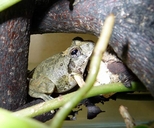|
Description
A small, slender frog. The mean snout-vent length for males is 28 mm (range 25-30) and for females is 35 mm (range 27-37). The snout is thick and the canthus blunt. The hindlimbs have well developed webbing, but the forelimb has none. There is a pair of slit-like vocal openings. In males, the nuptial pads are yellow. No dorsolateral fold exists, but the supratympanic fold is very prominent. The skin on the back is full of short tubercles and ridges (Maeda & Matsui 1990).
Distribution and Habitat
Country distribution from AmphibiaWeb's database: Japan, Taiwan
Buergeria japonica is found in both Taiwan and Japan. In Japan, the species is specifically found on the Ryuku archipelago (or Nansei Islands). It can be found in a wide variety of habitats including, lowlands, near the seashore, and the forests in mountainous regions. The species usually lives on the ground or on rocks, and is seldomly found in trees (Maeda & Matsui 1990).
Life History, Abundance, Activity, and Special Behaviors
Buergeria japonica has limited breeding sites. Tadpoles on this island were found in hot springs, and a study (Komaki et al. 2016) reports on the thermal tolerance of the species. The highest temperature of a pool occupied by tadpoles was 46.1 °C. Experiments show that this is very close to the critical thermal maximum of the species. Other frogs are known to inhabit hot springs but this is the highest temperature recorded in nature. Possible reasons for amphibian decline General habitat alteration and loss
Comments
This species was featured in News of the Week August, 1, 2016:
What are the highest temperatures that frogs can tolerate? Kuchinoshima Island is a tiny (13.33 km2) volcanic island in the Tokara group, just south of the main islands of Japan. It harbors a population of the Ryukyu Kajika Frog Buergeria japonica, which has limited breeding sites. Tadpoles on this island were found in hot springs, and a new study (Komaki et al., Amphibia-Reptilia 2016) reports on the thermal tolerance of the species. The highest temperature of a pool occupied by tadpoles was 46.1 °C. Experiments show that this is very close to the critical thermal maximum of the species. Other frogs are known to inhabit hot springs but this is the highest temperature recorded in nature. (Written by David B. Wake)
This species was featured in News of the Week November 15, 2021:
Many species of frogs and toads call in large choruses. However, communication can be difficult when multiple individuals are calling at the same time, like humans trying to hold a conversation at a crowded party. When multiple male frogs are calling at the same time, female attraction to individual calls is often reduced. Despite this cost, males of some species deliberately overlap their mating calls, “synchronizing” their signals. Legett et al. (2021) examined the potential functions of synchronized mating calls in a Japanese treefrog, the Ryukyu Kajika Frog (Buergeria japonica). They found that call synchronization may benefit male Ryukyu Kajika frogs in two ways. One, synchronized calls are louder than non-synchronized calls, attracting females to the chorus from a greater distance. Two, synchronized calls reduce the attraction of predators and parasites, such as frog-biting mosquitoes. Interestingly, female Ryukyu Kajika frogs attraction to individual calls was not affected by synchronization, suggesting that relaxed sexual selection may be key to the evolution of synchronized signaling strategies. (Written by Henry Legett)
References
Komaki, S., Lau, Q., Igawa, T. (2016). ''Living in a Japanese onsen: field observations and physiological measurements of hot spring amphibian tadpoles, Buergeria japonica.'' Amphibia-Reptilia, 37(3), 311-314. [link]
Maeda, N. and Matsui, M. (1990). Frogs and Toads of Japan, 2nd edition. Bun-Ichi Sogo Shuppan Co., Ltd., Tokyo, Japan.
Originally submitted by: Ambika Sopory (first posted 2000-10-16)
Edited by: Vance T. Vredenburg, David Wake and Sierra Raby (2019-01-08), Michelle S. Koo (2024-02-05)Species Account Citation: AmphibiaWeb 2024 Buergeria japonica: Ryukyu Kajika Frog <https://amphibiaweb.org/species/4635> University of California, Berkeley, CA, USA. Accessed May 5, 2025.
Feedback or comments about this page.
Citation: AmphibiaWeb. 2025. <https://amphibiaweb.org> University of California, Berkeley, CA, USA. Accessed 5 May 2025.
AmphibiaWeb's policy on data use.
|







 Map of Life
Map of Life